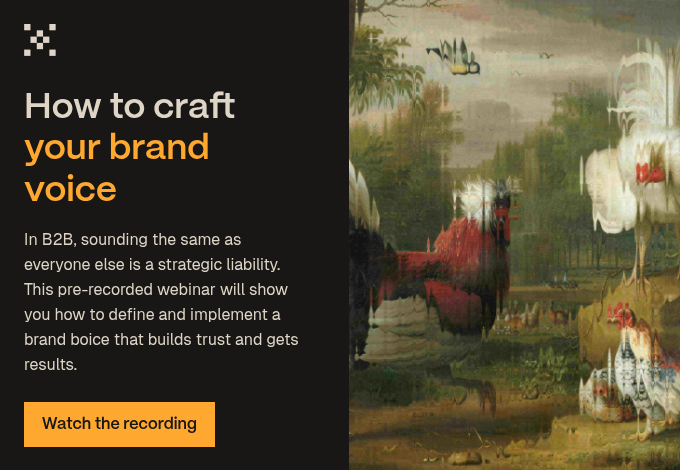Brand personalities aren’t just for Dead Happy and Compare the Market. B2B tech brands can (and should) develop a distinctive brand, while retaining their authority as a serious provider for ambitious businesses.
This article is based on one of our webinars. Sign up for live events here. View the recording and download the slides below:
The death of your brand personality: the smooth pebble
The biggest problem in marketing for tech companies is the allure of the smooth pebble. A smooth pebble is a piece of marketing collateral — a blog, for example — that nobody can object to.
Sounds like a good idea, at first. Except the smooth pebble is where your brand personality goes to die.
'If you’re constantly buffing yourself down, you might feel more smooth, but smooth isn’t interesting. Smooth is flat. Smooth is dull. Smooth is, for lack of a better word, NICE.'
— Ash Ambirge, The Middle Finger Project
Basically, it’s boring, which is not ideal for marketing.
You can end up with a smooth pebble for all sorts of reasons, but usually it’s laziness, ignorance, incompetence or fear. Or such phenomena as Groupthink (marketing by committee) and HiPPO (the ‘highest paid person’s opinion’ carries the most weight). All these issues derive from a weak core as a business. Meaning, a lack of vision and a poor understanding of the fundamentals around audience, messaging and brand identity.
Here are some examples of how the smoothing process manifests itself in conversation. These will help you identify and resist the smooth pebble.
1. ‘We want to sound professional.’
‘Professional’ is meaningless. Expertise isn't boring. You don't have to write like a PhD thesis to be professional, or to convey your expertise. In fact, if you try to sound big and clever by using complicated words jam-packed into passive sentences, you smooth the pebble. In pursuit of something that you think sounds ‘professional’, you end up alienating your audience.
Expertise is exciting. As marketers, we love people who know what they're talking about. We love helping them find a way of communicating that knowledge in a way that grabs you by the lapels. We love learning from them ourselves.
2. The Man in the Mirror problem
This manifests itself in two ways. The first way is assuming that the person you are communicating with is like you. They have the same motivations, interests, experience and background as you. But most people are not like you and they don’t spend their time thinking about your business. So, don’t tell them what you want to hear.
The second way is to make some other kinds of assumptions about your audience. Once, we had someone ask us if we’d put a typo in an article when we used a female pronoun to refer to a CIO. They were assuming all CIOs are male, which is exclusionary, biased and untrue.
3. ‘Not technical enough’
We hear this feedback from the technical experts, usually accompanied by reams of copy that sounds like it came out of a user manual. We understand, we really do. But when it comes to marketing technology, writing for the technical expert will often mean using unfamiliar, complex or technical language that doesn’t resonate with potential buyers. In fact, if you’re creating top-of-funnel SEO content, then you don’t want to get into the weeds of technical specifications, even if you are talking to a technical audience. Context, people.
The ability to explain something complicated in a simple way is a mark of intelligence. So, calibrate your messaging for someone who is not an expert.
4. ‘It’s too glib and jokey’
Sexy headlines, metaphors, stories, a bit of arresting language — these all grab attention. But tech companies are terribly important and serious, so they often resist anything that they view undermines this position. But the truth is, this is how people are used to digesting information. Look at The Economist. Snappy headlines, serious topics. It’s possible to do both.
Tech companies that stand out: proof you can avoid the pebble
These are the companies that zig when others zag. If you can see some common trends in your competitors (truth be told, every single MSP website in the UK is almost identical to every other one) then do something, anything, else. You could try talking about who you are, not what you do, for example. That’s powerful, because who you are, how you work - that’s unique and it’s a story. People engage with stories.
Yes, Articulate is one of thousands of marketing agencies. But we have a Chief Happiness Officer. We’re a B Corp. We want to be very progressive as a business. Talking about that aligns our values with our clients’ values. It makes us stand out. That’s one way we try to differentiate ourselves.
Virgin Atlantic
You can have a little bit of chutzpah and sex appeal, cheek and wit. Virgin Atlantic are good at this. Aeroplanes are deeply technical. They cost hundreds of millions of pounds. It takes years for a pilot to get qualified. From the functional perspective, all planes basically work the same way. But Virgin manages to stand out, all because they’ve taken a certain stance with their marketing.
Apple
Apple do some amazing storytelling. Most of our clients would have deep respect for Apple's positioning. You can’t argue with their success. And yet think about it for a second. The experience of using a Mac is pretty similar to using a Lenovo or an HP laptop. You use apps, you browse the web, there’s a screen, there’s a keyboard. Fundamentally, the difference is marketing. They’ve managed to create a brand personality around a commoditised technical product.
Watch this video on if Microsoft did Apple’s iPod packaging. It’s a bit old, but it illustrates this point perfectly.
Answer the Public
You can put a personality into your brand. Take the grumpy old guy (who bears more than a passing resemblance to Scott Galloway) on the Answer The Public website. Find ways of bringing character, literally character, into your marketing. We have a robot personality, Artie, who’s rather loveable and who represents us on our website:
.jpg?width=1721&name=Untitled%20(97).jpg) How to demonstrate technical expertise (without being boring)
How to demonstrate technical expertise (without being boring)
So, how do you take that smooth pebble and skim it out to sea? And how do you find those jagged edges that will catch your customers (without tripping anyone up along the way)?
Simplify and focus
Cut out the detail, narrow down the focus, have fewer messages. Be a hedgehog, not a fox. A hedgehog knows one big thing; a fox knows many small things.
Guaranteed, anyone with a carousel on their homepage is trying to tell multiple stories to multiple people. Tell-tale failure to simplify and focus. HP’s website has a carousel. Apple’s doesn’t.
Hire good writers
Writing is an art. It's hard. It comprises careful research, creative writing, thoughtful editing. There's more to it than just pretty sentences. As writers, we would say that.
Invest in design
ChemAxon, a client of ours, use design to illustrate their deeply technical work in a digestible way on their website. With design, you can display, communicate and package complicated information without diluting or distorting the underlying content.
Get yourself a MacGuffin
In fiction, a MacGuffin is an object, device, or event that is necessary to the plot and the motivation of the characters, but is itself insignificant, unimportant or irrelevant.
In business, a MacGuffin is a way of packaging and representing information in a unique way. Goldman Sachs talk about ’Carbonomics’, for example. They’ve taken reducing CO2 emissions and put their spin on it. Essentially, they’ve made up the term so they can take ownership over the idea and tempt people with their one-of-a-kind service.
Be a real thought leader
Thought leadership is much harder than a MacGuffin, but is worth the effort. Yes, you actually have to do some work. McKinsey does this really well. If you’re in a position to gather some data or provide insight through an annual report, for example, that’s genuine thought leadership. That’s powerful.
Get out of the negative: from pebble to personality
There are three possible scenarios for your brand personality, and they are:
- Minus One. Your website and brand communications are hard to understand, jargon-heavy, poorly designed and all about you. You don’t want to be here.
- Zero. Now, you’ve deployed some good design. Your copy is well-sourced and written, relevant, useful and interesting. This is necessary, but not enough.
- Plus One. You’ve got a distinctive tone of voice and coherent visual identity as a brand. Your brand personality is supported by real ‘reasons to believe’. This is what we’re aiming for.
If you’re in the red, or living from metaphorical paycheck to metaphorical paycheck, then we suggest enlisting our help. We can work out a strategy with you, give you the right tools to build your brand, and even roll up our sleeves to do some of this work for you.
With our range of inbound marketing services, we build difference engines for B2B tech companies. If you want one, contact us.







.jpg?width=400&height=250&name=museum-of-new-zealand-te-papa-tongarewa-tQG9yuNiCkc-unsplash%20(1).jpg)